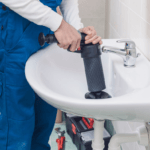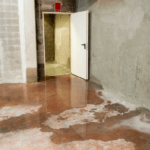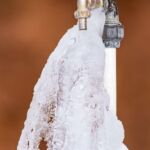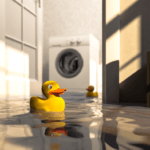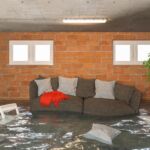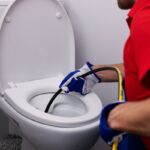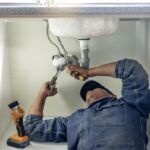The possibility of frozen pipes becomes a serious concern for homeowners as winter’s frost sets in. Your home’s exposed pipes could freeze and potentially break when the temperature drops below freezing, resulting in water damage and expensive repairs. But with the correct precautions, you can safeguard your pipes and guarantee a worry-free and safe winter.
This article gives crucial advice for protecting your property, preventing pipes from freezing and avoiding the hassle of dealing with frozen and burst pipes.
Tips To Prevent Your Pipes From Freezing:
If you suffer from frozen pipes during winter, the following things will help prevent your pipes from freezing.
Keep Your House Warm
Keeping the interior warm is one of the most important stages in keeping pipes from freezing. Even while you are gone from home, keep the temperature on your thermostat consistent.
Maintaining the thermostat set at least 55 degrees Fahrenheit (12.8 degrees Celsius) is typically advised to avoid freezing your pipes. Even though you might be tempted to cut back on heating expenses, letting your house get too cold might result in frozen pipes and serious water damage.
Insulate Exposed Pipes
Unheated or inadequately insulated pipes are particularly susceptible to freezing. Use pipe insulation sleeves or heat tape to insulate any exposed pipes in your basement, crawl space, attic, or exterior walls.
By maintaining a greater temperature inside the pipes, this additional layer of defence lessens the likelihood that they may freeze. To keep cold air from leaking into the pipes, insulate any openings or cracks in the foundation and walls.
Seal Drafts and Openings
The likelihood of your pipes freezing increases if there are drafts around your windows, doors, and vents, which can let cold air into your house. To fill in any gaps and openings, use caulk and weatherstripping. To reduce cold air infiltration, consider adding door sweeps to outside doors.
Let Faucets Drip
Allow faucets along external walls to drip slightly on particularly cold nights. The risk of freezing can be decreased by allowing a small, continuous flow of water to prevent water from growing stagnant inside the pipes. Keeping faucets open can be an efficient preventive strategy because moving water is less likely to freeze.
Open Cabinet Doors
Open cabinet doors in rooms with colder temperatures, such as the kitchen and bathroom, to facilitate the flow of warm air from the rest of the house. This simple yet effective technique can make a significant difference in preventing pipes from freezing. Exposing the pipes under sinks and along exterior walls to the warmer indoor air creates an environment that reduces the risk of freezing.
As the warm air circulates the pipes, it works to maintain a more constant temperature. This, in turn, prevents the pipes from dropping to freezing temperatures and minimizes the possibility of ice formation.
Use Pipe Heating Cables
When dealing with remote or extremely cold locations, pipe heating cables are an efficient solution to prevent frozen pipes. These cables are designed to wrap around the pipes, providing a consistent and controlled source of low-level heat. By delivering this heat directly to the pipes, pipe heating cables create a buffer against freezing temperatures.
Pipe heating cables come with the advantage of being versatile and adjustable. They can be tailored to fit the length of your pipes and used on exposed and concealed pipes. Some advanced models even have built-in thermostats that activate the cables when the temperature drops to a critical level.
Drain Outdoor Faucets and Hoses
Outdoor hoses should always be disconnected and drained for two reasons. The first benefit is that it stops water from freezing inside the hoses, which might harm both the hoses and the linked pipes. The possibility of water backing up into faucets and freezing there is also decreased.
Simply disconnect the hoses from the outdoor faucets and let any remaining water drain out to implement this precautionary step. When the hoses are empty, store them somewhere protected. To further prevent water from entering the faucet and causing it to freeze, ensure the outdoor water supply is shut off.
Install Smart Home Technology
Think about investing in home temperature monitoring technology. If the temperature dips to a dangerous level, certain smart thermostats can send notifications to your smartphone, enabling you to take prompt action to avoid frozen pipes.
Consider Adding Insulation to Attics and Basements
In addition to helping prevent frozen pipes, a well-insulated attic and basement can contribute to overall energy efficiency. Pipes are less likely to freeze in these regions because of proper insulation, which creates a warmer atmosphere.
Prepare for Vacations
Take additional care to avoid frozen pipes if you intend to be away from home during the winter. Set your thermostat above freezing and enlist the help of a neighbour or dependable friend to routinely check on your house.
Understanding the Causes of Frozen Pipes
But before you implement the tips to prevent your pipes from freezing, it’s vital to know the cause of frozen pipes to tackle the situation effectively. When pipes are exposed to exceptionally cold temperatures, the water inside freezes, resulting in frozen pipes. This phenomenon is caused by several things, including:
- Temperature Drops: Exposed pipes are vulnerable to freezing when temperatures drop below zero, especially during protracted cold spells.
- Inadequate Insulation: Pipes in unheated places like basements, attics, crawl spaces, and external walls are more susceptible to freezing due to insufficient insulation.
- Lack of Heat: Pipes may not stay above freezing temperatures in locations with little heating, empty rooms, or deserted buildings.
- Exterior Faucets and Hoses: Because they are exposed to the cold air directly, outdoor faucets and hoses are more vulnerable to freezing. Frozen water in hoses can seep into the linked pipes.
The Risks of Frozen Pipes
Frozen pipes can lead to a cascade of problems, including:
- Burst Pipes: When water freezes inside a pipe, it expands and increases pressure. This pressure can cause pipes to crack or burst, leading to significant water damage.
- Water Damage: Burst pipes can release a significant amount of water into your home, causing damage to walls, floors, ceilings, and belongings.
- Structural Damage: The force of water from burst pipes can weaken the structural integrity of your home, leading to expensive repairs.
- Mold Growth: Water damage from burst pipes creates an environment conducive to mold growth, which can compromise indoor air quality and pose health risks.
- Disruption: Dealing with burst pipes requires immediate action, which can disrupt your daily life and routine.
Final Words
Pipe freezing must be avoided through proactive measures and thorough planning. Prepare your home for the impending winter’s chilly weather and probable freezing rain. You may have peace of mind knowing that your pipes are protected from freezing temperatures and that your home is protected from the dangers of frozen pipes by putting the proper preventive measures in place.
Experience Plumbing Excellence with Tap Tech
Are you in need of 5-star plumbing services catering to your residential and commercial needs? Look no further than Tap Tech – your trusted partner for plumbing excellence!
Tap Tech delivers unparalleled plumbing solutions for residential and commercial properties. With years of experience and a team of skilled professionals, we are equipped to handle a wide range of plumbing needs, from minor repairs to major installations.


